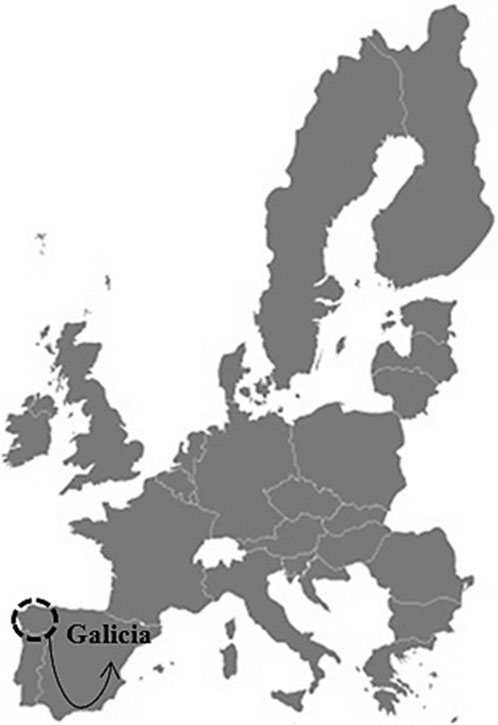- CRETUS, Departamento de Edafoloxía e Química Agrícola, Universidade de Santiago de Compostela, Santiago de Compostela, Spain
Production of agricultural pesticides underwent an exponential increase during the 20th century. Many of these pesticides have since been prohibited because they are toxic and because they are bioaccumulated and persist in the environment. Detailed knowledge about any substance that is applied to land is essential to enable evaluation of potential contamination effects and the risk of latent exposure to these types of substances. However, accurate determination of the type and amounts of pesticides used throughout the history of agriculture in Spain is greatly complicated by the absence of historical records, scarce control of use and the lack of effective legislation until well into the 21st century. The aims of this study were: 1) to elaborate an inventory of the active substances of the agricultural pesticides (phytosanitary products) used in Galicia throughout the 20th century, 2) to develop a model of their geographic distribution by using a geographic information system (GIS), and 3) to contrast the geographical model obtained for selected persistent pesticides with the presence of these compounds in raw water. We consulted a large variety of sources of information and carried out a geographic analysis for the most commonly used pesticides in different crops. We inventoried a total of 176 active substances belonging to more than 50 different classes of chemicals and observed a clear geographic zoning according to the chemical class and mode of action of the substances. The presence of pesticide residues at drinking water extraction points is consistent with the geographic delimitation established in the study.
Introduction
The 20th century was a period of intense development for many industries, including the agrochemical sector. Major growth of this industry occurred after the Second World War, particularly during the Green Revolution in the 1960s. New organic synthetic pesticides were produced during this period by one of the most rapidly adopted technologies in the history of agriculture worldwide (March et al., 2010). The consumption of pesticides increased exponentially between the 1970s and 1990s, when it reached maximal levels (Carvalho, 2006; Zhang W. et al., 2011). At the end of the 20th century, some 700 active pesticide substances were authorized for use in Europe and some 6000 different pesticides are authorized for use throughout the world (Juraske, 2007).
The benefits provided by pesticides in relation to the control of pests and diseases, agricultural development and food quality are widely recognized (Navarro et al., 2007). Currently, almost 3 million tons of pesticides per year are used worldwide and more than 400,000 tons are applied in Europe alone (FAOSTAT, 2021). However, only a very small portion of the amounts applied to crops, generally less than 0.1 percent, reaches the target pest (Pimentel, 1995; Torres and Capote, 2004). Pesticides are mobile in the atmosphere and water and are accumulated and transformed mainly in the soil, where they can be toxic to non-target species, persistent, bioaccumulative and/or biomagnified. Then, although pesticides are designed to provide a highly specific mode of action, their intensive and prolonged use, inappropriate application, and the generation of residues contribute to environmental pollution and represent a risk to human and animal health. The environmental persistence is perhaps best exemplified by the organochlorine compounds, the residues of which have been identified in diverse environmental matrices worldwide (Skrbic and Durisic-Mladenovic, 2007).
The first specific European Directives relating to pesticides concerned the maximum allowed contents of pesticides in fruits and vegetables (Council Directive 76/895/EEC) and the prohibition of active substances due to their toxic effects on human and animal health and on the environment (Council Directive 79/118/EEC). Council Directives 91/414/EEC and 98/8/CE relating respectively to the commercialization of phytosanitary products (agricultural pesticides) and the commercialization of biocides (no agricultural pesticides) appeared in the 1990s. These Directives controlled the commercialization of pesticides in the European Union until well after the beginning of the 21st century.
Despite this regulatory framework, the European Union recognized that the prevailing legislation was not completely effective in protecting against the risks to health and the environment derived from the use of pesticides (European Commission, 2006). To correct this deficiency and to create a consistent global framework (regarding pesticide use), the Thematic Strategy for the Sustainable Use of Pesticides was developed within the VI Environmental Program established by the European Council and Parliament for the period 2002–2012 and was adopted by the European Commission on 12 July 2006. Recently, the Farm to Fork Strategy (F2FS) for a fair, healthy and environmentally friendly food system was adopted as a key element of the Green Deal. The F2FS aims, among other things, to reduce by 50% the overall use and risk of chemical pesticides and the use of more hazardous pesticides by 50% by 2030 (European Commission, 2020).
Spain incorporated the main rules derived from the directive and the aforementioned strategy (Directive 2009/128/EC and Regulation 1107/2009/EC) via Royal Decree 1311/2012, 14 September, which established the framework of action for the sustainable use of phytosanitary products. The National Action Plan for the sustainable use of phytosanitary products (PAN, Spanish acronym for Plan de Acción Nacional) came into force on 10 December 2012 (PAN 2013–2017), which was later reviewed and updated (PAN 2018–2022, PAN 2023–2024) (MAPA, 2022a).
The first strict rule that appeared in Spain regarding information about the amounts of phytosanitary products consumed was Order APA/326/2007, 9 February, which was established because of the transposition of Regulation 852/2004/CE, 29 April, regarding food product hygiene. However, it was not until 2011, via another regulation derived from “The Strategy” (Regulation 1185/2009/EC), that a questionnaire on the Commercial Use of Phytosanitary Products began to be administered to all producers/sellers of these products. In 2014, as part of the National Action Plan, statistics on the use of phytosanitary products were compiled from the results of questionnaires administered to the owners/managers of agricultural exploitations. Both instruments provide accurate statistical data on the amounts of active substances produced, consumed, and applied to the main crops grown in the Spanish agricultural sector.
It can be concluded that during the 20th century development of pesticide-related legislation did not occur at the same rate as either the pesticide industry or the agricultural sector. It was not until after the beginning of the 21st century that strict rules began to be applied in relation to controlling pesticide use in agriculture by compulsory recording of the exact amounts of pesticides used. Consequently, information about the types and amounts of phytosanitary products applied and about the crops to which they were applied is scarce, disperse and difficult to access.
The objectives of this study were: 1) to compile an inventory of the active substances of the agricultural pesticides (phytosanitary products) used in Galicia throughout the 20th century, 2) to develop a model of their geographic distribution by means of a geographic information system (GIS), and 3) to contrast the geographical model obtained for selected persistent pesticides with the presence of these compounds in raw water. For this purpose, we used a variety of sources of information and carried out a combined geographic analysis of the most commonly used pesticides and of the agricultural land destined for production of the main crops grown in Galicia.
Materials and Methods
Study Area
This study focuses on the autonomous community of Galicia, located in north-west Spain and bordering with northern Portugal (Figure 1). Occupying a surface area of 29.547 km2, Galicia is the seventh largest autonomous community in Spain and is slightly larger than the region of Valencia and of similar size to Belgium. It covers four provinces (Coruña, Lugo, Ourense and Pontevedra) and three hundred and thirteen municipalities wich are the smallest administrative subdivisions in Spain and represent the minimum mapping unit of most Spanish statistical surveys (Serra et al., 2014).
The climate in the region varies from oceanic to continental Mediterranean. Mean precipitation levels are high, although variable, with some zones receiving less than 700 mm yr-1 and others more 2000 mm yr-1 (Supplementary Figure S1). The mean temperature ranges between 8°C and 14°C (Sánchez et al., 2014). The frost risk period lasts between less than 3 months in coastal areas, to more than 9 months in the highest mountain areas in the provinces of Ourense and Lugo (Corbelle et al., 2014). The lithology is varied, there being a predominance of acid rocks (granite, quartz schists and shales) and a lower proportion of basic (gabbros and amphibolites) and ultramafic rocks (serpentinites). According to World Reference Base (IUSS Working Group WRB, 2015), the soils are mainly classified as Haplic/Andic Umbrisols on acid rocks, Umbric Andosols on basic rocks and Haplic Phaeozems on serpentinites (Calvo de Anta et al., 2015).
Galician agriculture, which is characterized by smallholdings, polyculture and intensive labor, has been classified as subsistence agriculture since the second half of the 20th century. Agricultural land use in Galicia has traditionally been closely linked to the geochemical and morphological characteristics of the land. The relief is hilly in a large part of the region (more than 76% of the land in Galicia is located at altitudes of between 201 and 1000 m) with a predominance of shallow, acid soils typically with low levels of natural fertility and other limiting edaphic features (leading them to be described as, e.g., stony, hydromorphic and of heavy texture) (Macías, 1992). Until the first half of the 20th century, the main crops were grown in the area were as follows: corn, first grown for grain, with later incorporation of forage varieties; wheat, rye, and barley, rotated annually with corn; potato, initially grown as a fodder crop and later for human consumption; grapes, produced in certain regions; and fruit trees, distributed widely throughout the region. This system went into crisis in the early 1960s, and the subsequent adaptation to market conditions and to social changes greatly modified the agricultural landscape in Galicia (Macías, 1992; Torres Luna, 1992). Greenhouse cultivation of vegetables and flowers began to be introduced in this period.
The incorporation of Galicia (as part of Spain) in the European Union (1986), considered unsatisfactory by some authors (Colino et al., 1999; Soto, 2006; Sineiro, 2008), was definitive in the transformation of the agricultural landscape. Between 1985 and 2005 volume of cereals and potatoes produced decreased, while the value of vegetable production did not increase, and although wine production increased in value, there was no increase in the amount produced (Sineiro, 2008). The most notable change in the farming sector during this period was the increase in milk production, closely related to the cultivation of mixed artificial grassland and forage for dairy livestock. At the beginning of the 21st century, the intense specialization of farming in Galicia determined the land use distribution, with production of vegetable fodder crops predominating (López, 2000; Xunta de Galicia, 2002; Balboa et al., 2004).
Period of Study and Sources of Information
The use of agricultural pesticides in Galicia during the period 1900 to 2000 was analyzed in the present study. For this, we consulted numerous and diverse sources of information throughout the study.
First, we obtained historical information about pesticide consumption, in terms of economic value, from statistical records and studies of agrarian macroeconomic magnitudes in the primary sector (Soto, 2002; MAPA, 2021). We also consulted published data on the amounts of phytosanitary products produced at the end of the 1980s, made available by the Asociación Empresarial para la Protección de las Plantas (AEPLA) (Business Association for Plant Protection) to different public organizations. Some of this information has recently been analyzed in relation to the mode of pesticide action (fungicides, insecticides, acaricides, herbicides, etc.) (IAEST, 2015).
On the other hand, although the information obtained from bibliographic references and sources is disperse and incomplete, we have consulted the summaries and abstracts published in historical archives: “Boletín de la Granja-Escuela Experimental de La Coruña” (Ministerio de Agricultura, 1899), now the Centro de Investigaciones Agrarias de Mabegondo; “Cuadernos da Área de Ciencias Agrarias” (Muñiz de las Cuevas, 1988); the publication “100 años de Investigación Agraria. 1888–1988” (Pérez Vidal, 1992), and in other monographs (Xunta de Galicia, 1991). The most recent data were reproduced from Carballeira and Aboal (2000), who detailed the amounts of pesticides (grouped by mode of action) applied to the main crops grown in Galicia in the 1980s and 1990s.
The recent introduction of ICTs (Information and Communication Technologies) has enabled comparison of larger amounts of data via the phytosanitary notices published, since 1981, by La Estación Fitopatolóxica do Areeiro (the Areeiro Phytopathological Station) (Estación Fitopatolóxica do Areerio, 1981), and to find the most up-to-date information on different web portals, such as those of the Asociación Empresarial para la Protección de las Plantas (Business Association for Plant Protection) (AEPLA, 2016) (reports and statistics), the Ministerio de Agricultura, Pesca y Alimentación de España (Spanish Ministry of Agriculture, Fisheries and Food (MAPA, 2022b) (Phytosanitary records), and of various multinational pesticide producers (Bayer, Syngenta, Dupont, etc.) as well as other web portals such as InfoAgro and the associated “Agrovademecum.”
Finally, we obtained further information via semi-structured interviews and administration of questionnaires to a selected group of interest. After making initial contacts via various public and private organizations (public authorities, universities, CSIC, agricultural syndicates, commercial industries), we selected a group for interview that comprised people of recognized importance in the field of plant health in Galicia, belonging to leading scientific, professional and business institutions (i.e., Areeiro Phytopathology monitoring Station-CSIC, Galician agricultural syndicate Unións Agrarias, Bayer CropScience Spain for Galicia, and editorial of the Almanaque Agrícola, ZZ—Syngenta España).
Database of Active Substances
The information obtained was prepared in three stages, with the aim of compiling a comprehensive, standardized database: 1) comparison and combination of the bibliographic sources and personal inputs; 2) elimination of inconsistent data; 3) chronological ordering of the information.
Once the information was organized and revised, the Clasificación Armonizada de Sustancias (Standardized Classification of Substances) established in the annex of Commission Regulation (EU) 656/2011, 7 July 2011, which replaced annex III of Regulation 1185/2009, was applied in order to group the substances in relation to their mode and action and standardized chemical classification. In addition, the most recent update of the “Lista Comunitaria de Sustancias Activas Aprobadas, Excluidas y en Evaluación Comunitaria, Sustancias de Bajo Riesgos y Lista de Sustancias Básicas” (Community List of Active Substances Approved, Excluded and Under Community Consideration, Low Risk Substances, and List of Basic Substances) (MAPA, 2022c), dated 1 July 2022, was consulted in order to establish the prevailing regulations concerning each of the active substances inventoried. The following database categories were thus established: active substance, chemical formula, year of introduction, commercial products, target crop, chemical class, mode of action and legal status. The following modes of action were considered: insecticide, herbicide, fungicide, soil sterilizer and bird repellent.
Geographic Model of Use of Active Substances
For the geographical analysis, the variable accumulated use of active substances was calculated in each of the municipalities of Galicia. This variable considered: a) the area of agricultural land destined to a specific crop in each municipality, and b) the total number of active substances applied to each of these crops in the period 1900–2000. To simplify the analysis, the distribution of agricultural land (main crops) in Galicia in 1997 (Xunta de Galicia, 1999) was considered representative of the agricultural system at the end of the 20th century. The accumulated use of active substances (AU) was calculated (Eq. 1) according to: 1) their mode of action (MA; i.e., insecticides, acaricides, fungicides, herbicides, soil sterilizers and bird repellents), or 2) standardized chemical classification (CC; i.e., Organophosphate, carbamate, inorganic, conazole,....). In relation to the chemical classification, accumulated use was calculated for the 14 chemical classes of active substances most commonly applied (Table 1). Data are available as Supplementary Material.
where,
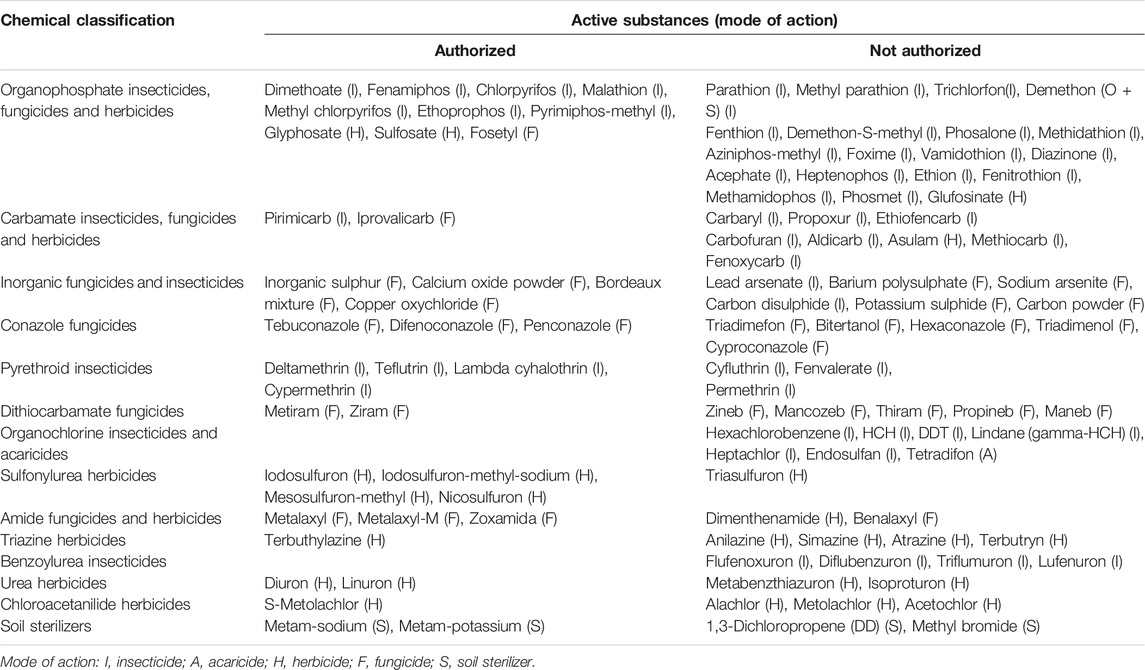
TABLE 1. Main standard chemical classes and main active substances introduced in Galicia between 1900 and 2000, classified according to the current legal status (Regulation 1107/2009, 1 July 2022).
The geographic analysis was carried out with gvGIS vs. 2.1. software, by classifying the variable accumulated use into 5 intervals. The intervals were calculated according to the method described by Jenk1 for optimizing the natural localization of intervals, considering five levels (very low, low, intermediate, high, and very high) of accumulated use of active substances, for each mode of action and chemical class.
Persistent Pesticides in Water
In order to contrast the geographical model obtained for selected persistent pesticides we consulted the records of the analysis of phytosanitary products in raw waters by different river basin development authorities (Demarcación Hidrográfica de Galicia Costa y la Confederación Hidrográfica Miño-Sil) (SERGAS, 2016).
Results and Discussion
Database of Active Substances
The research and literature review carried out in the present study revealed that a total of 176 active substances were introduced in Galicia during the period 1900–2000. In relation to mode of action, 41% of these were insecticides/acaricides, followed in order of abundance by fungicides (30%), herbicides (27%), soil sterilizers (2%) and bird repellents (1%) (Figure 2A). The greatest increase in the number of active substances introduced occurred between 1950 and 1980, coinciding with the period of highest consumption of pesticides in Galicia (Soto, 2002; MAGRAMA, 2016a). After 1980, the number of new substances introduced leveled off, although the number of herbicides introduced increased in line with the development of artificial grassland and forage corn in Galicia and the need for weed control. Of all of the active substances inventoried, 106 are currently prohibited and major of these (∼70%) were introduced between the 1950s and 1980s (Figure 2B).
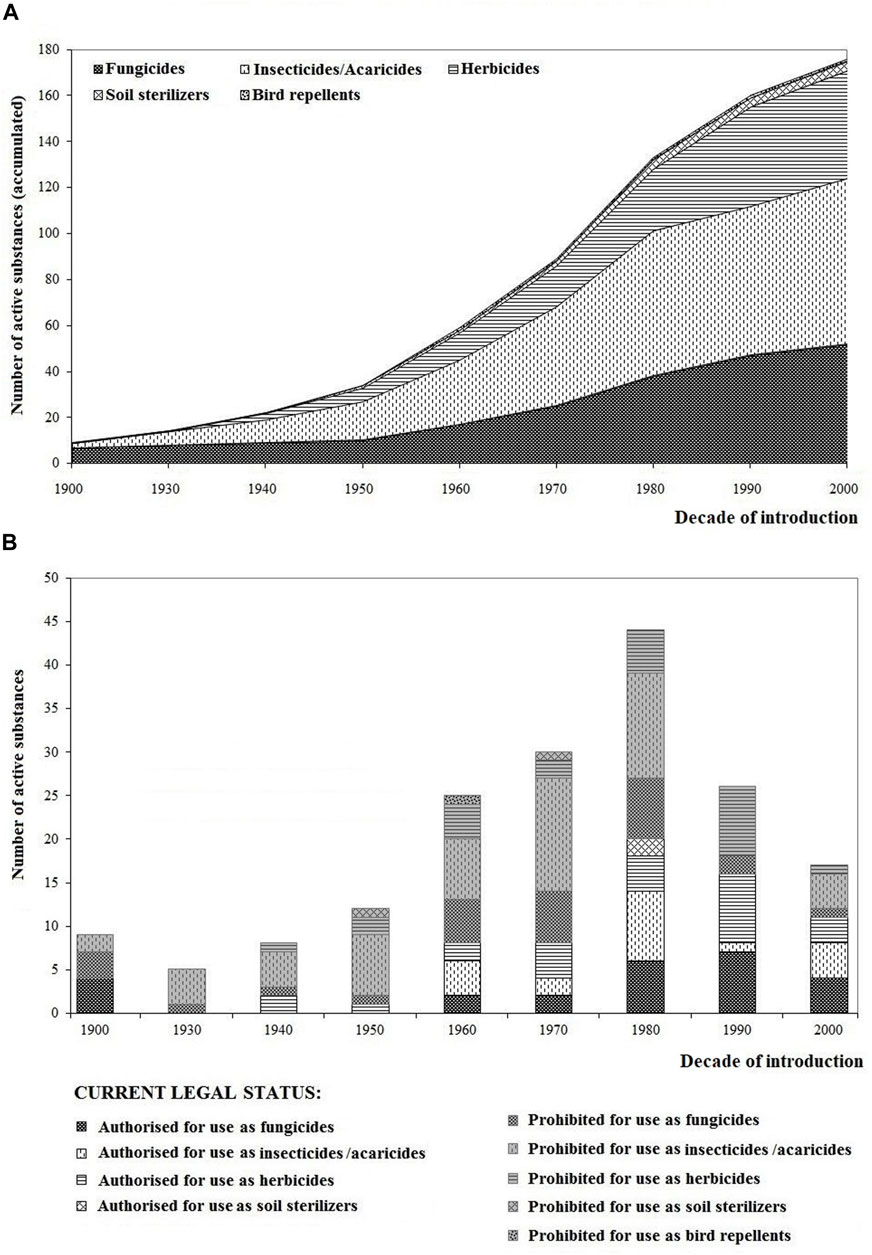
FIGURE 2. Accumulated number of active substances introduced in Galicia during the period 1900–2000, by (A) mode of action and (B) mode of action/legal status according to Regulation 1107/2009, 1 July 2022.
The active substances inventoried belong to more than 50 different chemical classes (Table 1; Figure 3). Fourteen of these chemical classes include more than 61% of all of the active substances inventoried and 66% of those substances currently prohibited under Regulation 1107/2009 (Table 1). Up until the mid 20th century, the most commonly used pesticides were the inorganic fungicides and insecticides, the biological insecticides, organochlorine insecticides, phenoxy herbicides and some mercurial fungicides and dinitrophenol derivatives. From the 1950s onwards, there was a great increase in the diversity of chemical classes available, and, e.g., the organophosphate insecticides, the chemical class that includes the largest number of substances, appeared during this period. Other important groups include the carbamate and pyrethroid insecticides, the dithiocarbamate fungicides, the chloroacetanilide, sulphonylurea and triazine herbicides, amongst many others.
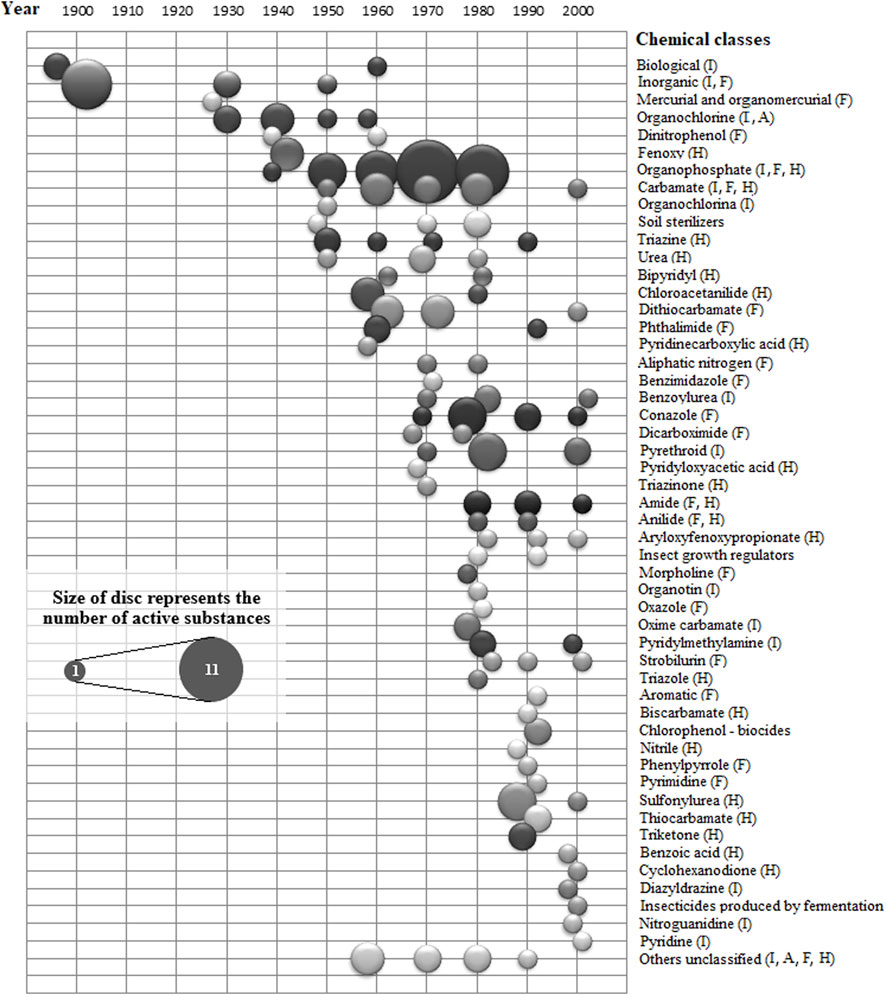
FIGURE 3. Abundance of active substances introduced in Galicia per year, during the period 1900–2000, according to standard chemical class. The modes of action in each chemical class are indicated in parentheses (I, insecticide; A, acaricide; H, herbicide; F, fungicide).
Geographic Model of Use of Active Substances
The results of the geographic analysis of the accumulated use of active substances during the 20th century, in terms of mode of action, shows a clear zoning within Galicia (Figure 4). The resulting Fungicides map (Figure 4A) reveals use of a greater number of substances in the Atlantic zone and the south of the province of Ourense, with a predominance of vine and potato crops. The Herbicides map (Figure 4B) shows the highest levels of use in areas specialized in growing fodder crops for livestock, as in the regions of Santiago and Xallas (A Coruña), Deza (Pontevedra) and Terra Cha (Lugo). The Insecticides map (Figure 4C) shows that the use of these compounds is extended throughout Galicia, with the intensity of use depending on the predominant crops and the climate, with consumption being particularly high in the above-mentioned areas in the province of Pontevedra. The map of Other substances (soil sterilizers and bird repellents; Figure 4D) showed a similar pattern to that of the insecticides. The zoning of the pesticide use obtained in this work showed a close relationship with the climatic variables (temperature, humidity, and duration of the frost period; Supplementary Figure S1), which, together with the type of crop, determine the incidence and proliferation of pests. Additionally, this zoning is consistent with that derived from the analysis of the amounts of pesticides (grouped by mode of action) used in the different provinces between 1990 and 2000 (Carballeira and Aboal, 2000). According to the aforementioned authors, the amounts of pesticides consumed, in relation to mode of action, depends on the degree of agricultural intensification in each province and on the type of substance and formulation of each pesticide. For example, in Pontevedra and Ourense, greater amounts of fungicides than of other types of pesticides were consumed, reflecting the large amounts of copper oxychloride and copper sulfate applied to potato crops and vines (Carballeira and Aboal, 2000). These results indicate, in general, a direct relationship between the number and amount of active substances used.
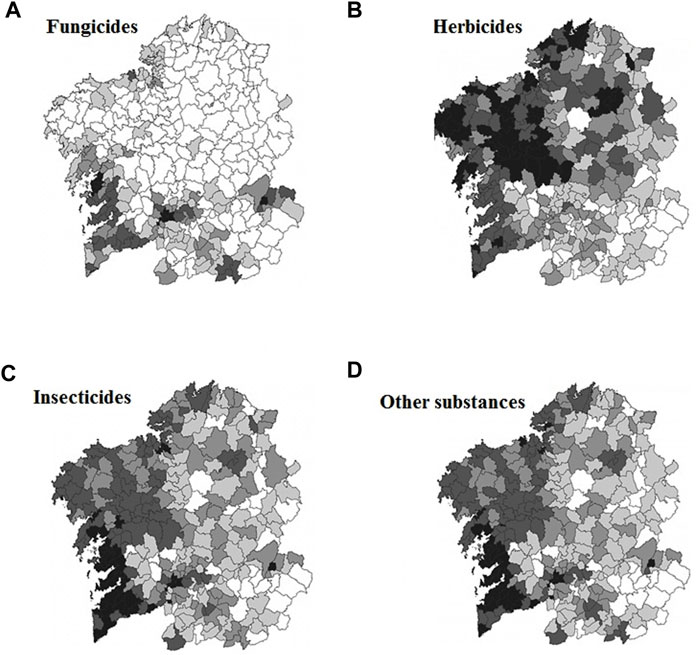
FIGURE 4. Geographic distribution of the accumulated use of pesticides for the period 1900–2000 according to the mode of action: (A) Fungicide, (B) Herbicide, (C) Insecticide/acaricide, and (D) Other substances (soil sterilizers and bird repellents).
On the other hand, the results of the geographic analysis of the accumulated use of active substances according to chemical class (Table 1) also reveals a marked zoning in Galicia in relation to the class of pesticide considered (Figure 5, and Supplementary Figure S2). For example, the greatest numbers (highest accumulated use) of inorganic pesticides (mainly fungicides; Figure 5A), and pyrethroids (mainly insecticides; Figure 5B), were used in the following areas: the Atlantic zone and the south of the province of Pontevedra, where there is an important tradition of growing vines and vegetable crops; the vine-growing regions of O Ribeiro, Monterrei and Valdeorras, and the region of A Limia (province of Ourense), known for producing potatoes; and to a lesser extent the regions of Coruña, Betanzos and Eume, in the province of A Coruña, where potato and vegetable growing are important (Xunta de Galicia, 1999). The climate in these areas, i.e., mild mean annual temperature (>13°C) and a short frost risk period (∼3 months), is also favorable both for agriculture and for proliferation of most pests.
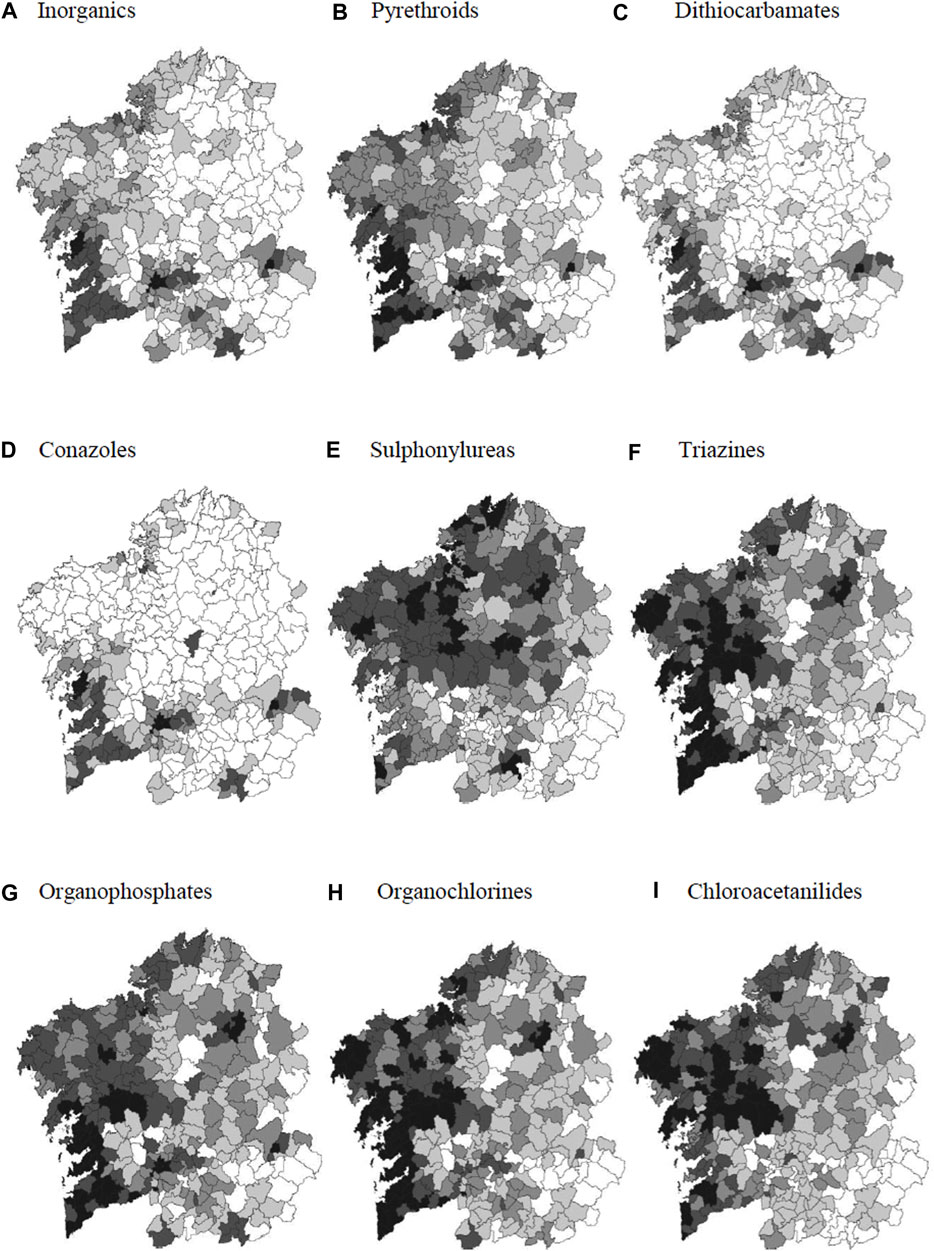
FIGURE 5. Geographic distribution of the accumulated use of pesticides for the period 1900–2000 according to standard chemical class: (A) Inorganic, (B) pyrethroids, (C) dithiocarbamates, (D) Conazoles. (E) Sulphonylureas, (F) triazines, (G) organophosphates, (H) organochlorines, (I) chloroacetanilides.
The distribution map for dithiocarbamate use (Figure 5C) is similar to that established for the inorganic pesticides as these compounds are also fungicides and are mainly applied to the same crops in the same areas as already mentioned. Use of the conazole fungicides was clearly delimited in the vine and fruit growing areas of Galicia at the end of the 20th century (Figure 5D). Use of the sulfonylureas (herbicides) was mainly concentrated in the northern half of Galicia, in the provinces of A Coruña and Lugo, where cereals (wheat) and fodder crops are traditionally grown (Figure 5E). The use of triazines, herbicides applied massively to corn and vines, was concentrated in the western half of Galicia (Figure 5F). The organophosphates, wide spectrum insecticides applied to many types of crops, were more widely distributed, although use in the Atlantic zone of Pontevedra is again highlighted, revealing this as one of the top pesticide-consuming areas in Galicia (Figure 5G).
Spatial distribution of the organochlorines appears mostly concentrated in Atlantic fringe of Galicia, where could had been applied mainly as insecticide to corn (Figure 5H). Another group of chlorinated pesticides, the chloroacetanilides, are herbicides that has been commonly used in a large number of crops (Liu et al., 2000), and its spatial distribution coincides with fodder and corn for grain cultivation areas in Galicia (Figure 5I).
Persistent Pesticides in Water
The long-term behavior and persistence of pesticides in soil depends on a number of factors involving the characteristics of the substances (volatility, solubility), the environmental factors (temperature, precipitation), and the soil properties (structure, organic matter content, clay content, microbial activity), (e.g., Edwards, 1975).
The pesticides most persistence in soils in this inventory are the chlorinated compounds (Zhang N. et al., 2011; Tzanetou and Karasali, 2022). The active substances of this group are now totally prohibited: DDT, lindane, endosulphan, heptachlor, etc. (organochlorines) and alachlor, metolachlor, acetochlor (chloroacetanilides). However, as a result of the environmental persistence of organochlorines, residues of these compounds are still being detected in different environmental matrices worldwide (Skrbic and Durisic-Mladenovic, 2007). Of the chemical class of chloroacetanilides, alachlor degrades relatively rapidly in the soil, although it can persist in surface waters for up to 500 days (FAO-UNEP, 2011). Lindane and metolachlor have recently been detected in surface waters in Galicia, during surveys carried out between 2010 and 2014 by local river basin authorities (“Demarcación Hidrográfica Galicia Costa” and the “Confederación Hidrográfica Miño-Sil” (SERGAS, 2016).
Substances belonging to the triazine class, specifically terbutylazine and atrazine, the latter of which is no longer authorized for agricultural use, were also detected in the same surveys. Comparison of the distribution of pesticides detected in raw waters in the surveys carried out between 2010 and 2014 (SERGAS, 2016) and the regional distribution map of the use of triazines elaborated in the present study showed that 79% of the regions where the substances in this groups were detected by the river basin authorities correspond to intermediate to very high levels of accumulated use of triazines established in the present study (Figure 6). The main discrepancy observed in this comparison is in the province of Pontevedra, where these substances were not detected in surface waters, despite the high level of use (Figure 5F). Triazines were mainly used in this area to control weeds in vineyards, but this practice was discontinued in the 1990s when it was discovered that the vegetation growing in vineyard soils helped to protect the soil and enhance its fertility. Additionally, vineyard soils usually present sandy textures and low organic matter content, compared to cereal/orchard soils in other areas (Calvo de Anta et al., 2015), which could have contributed to a high bioavailability of these pesticides, and further biodegradation.
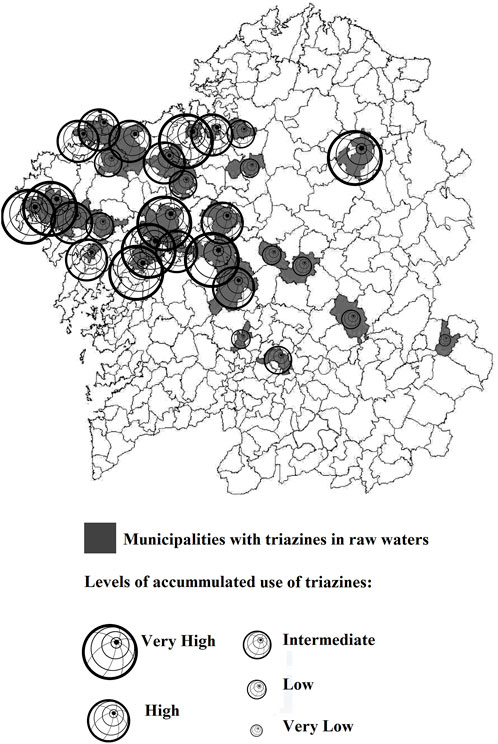
FIGURE 6. Municipalities of Galicia in which triazines have been detected in raw water during 2010–2014 (SERGAS, 2015) and level of accumulated use of triazines obtained in those municipalities.
Conclusion
Compilation of the inventory of the active substances of agricultural pesticides used in Galicia between 1900 and 2000 was complex, mainly due to the absence of historical records, as well as the particular characteristics of Galician agriculture and the mode of introduction of the treatments (via commercial businesses, agricultural extension agencies and agricultural cooperatives). The inventory includes 176 active substances applied to the main crops grown in Galicia during the 20th century, of which 106 are currently prohibited. The substances inventoried belong to 50 different chemical classes.
The greatest numbers of active substances were introduced for use in Galician in the period between the 1950s and the 1980s, coinciding with the Green Revolution worldwide. Thereafter, the appearance of new substances decreased and was influenced by reformation of the agricultural economics in Galicia, brought about by the entry of Spain in the European Union. A further substantial reduction is expected in the coming years thanks to the recently adopted European farm-to-fork strategy.
The geographic analysis of the accumulated use of active substances throughout the 20th century revealed a clear zoning of the region according to the mode of action and chemical classification. The spatial distribution was consistent with the pattern of agricultural production in Galicia, with the particular climate conditions in each area and with the data obtained regarding the amounts of pesticides (tonnes) used during the 1990s.
Many of the substances previously used in Galicia, and now prohibited, continue to appear in pesticide detection surveys, in, e.g., raw waters. The points where triazine pesticides were detected in this matrix and in recent surveys carried out by the Organismos Oficiales de Cuenca (River Basin Authorities) are consistent with intermediate to high levels of accumulated use in the geographic distribution map elaborated in the present study.
The maps produced in this work can serve as a basis for exploratory sampling designs aimed at detecting inventoried pesticides in different media (soils, water, biota) and contribute to environmental and biological monitoring programs to quantify exposure and assess pesticide risks.
Data Availability Statement
The raw data supporting the conclusion of this article will be made available by the authors, without undue reservation.
Author Contributions
RC is responsible for design, data mining, modeling, and writing; CM is responsible for the design, discussion, writing, and revision of the manuscript.
Funding
This work was funded by the Government of Spain (PID2019-107879RB-100/AEI/10.13039/501100011033) and the Xunta de Galicia (GRCED431C 2022/40), co-funded by FEDER (EU).
Conflict of Interest
The authors declare that the research was conducted in the absence of any commercial or financial relationships that could be construed as a potential conflict of interest.
Acknowledgments
Special thanks to J. Pichel, ex-delegate of Bayer CropScience Spain for Galicia, for his contribution to the preparation of the inventory of active substances used in Galicia.
Supplementary Material
The Supplementary Material for this article can be found online at: https://www.frontierspartnerships.org/articles/10.3389/sjss.2023.11197/full#supplementary-material
Footnotes
1The categories were constructed using an algorithm that groups similar values and maximizes the differences between classes. The class boundaries are located where there are large increases in the values of the data. This is the method most commonly used in GIS applications.
References
AEPLA (2016). Memoria de actividad de la Asociación Empresarial para la Protección de las Plantas 2015. Available from: http://www.aepla.es/tmp/images/publicaciones/P0022_Memoria_AEPLA_2015.pdf (Access September 20, 2016).
Balboa, X., Fernández, L., Soto, D., Besteiro, B., Fernández, X., Jordán, M., et al. (2004). La devolución de la propiedad vecinal en Galicia (1960-1985). Modos de uso y conflicto de propiedad. Hist. Agrar. 33, 105–130.
Calvo de Anta, R., Luis Calvo, E., Casás Sabarís, F., Galiñanes Costa, J. M., Matilla Mosquera, N., Macías Vázquez, F., et al. (2015). Soil Organic Carbon in Northern Spain (Galicia, Asturias, Cantabria and País Vasco). Span. J. Soil Sci., 5(1), 41–53. doi:10.3232/sjss.2015.v5.n1.04
Carballeira, A., and Aboal, J. (2000). Banco de especímenes ambientales: Una propuesta para Galicia. Ed. 105. Santiago de Compostela: Universidade de Santiago de Compostela, Servicio de Publicacións e Intercambio Científico, 110.
Carvalho, F. (2006). Agriculture, Pesticides, Food Security and Food Safety. Environ. Sci. Policy 9, 685–692. doi:10.1016/j.envsci.2006.08.002
Colino, J., Noguera, P., and Aboal, M. (1999). La agricultura gallega en la Unión Europea: balance del primer decenio. Galicia: Fundación La Caixa Galicia, Santiago de Compostela. ISBN 84-89231-94-X.
Corbelle, E., Vila, D., Crecente, R., and Díaz-Fierros, F. (2014). Dixitalización Do mapa de capacidade produtiva dos solos de Galicia. Recur. Rurais, núm 10, 35–43. doi:10.15304/rr.id3321
de Galicia, X. (2002). Anuario de Estadística Agraria 2000. Consellería de Medio Rural. ISBN 978-84-453-3323-5.
de Galicia, X. (1999). Anuario de estatística agraria 1997. Cons. Medio Rural, 369p. ISBN 978-84-453-2366-3.
Edwards, C. A. (1975).Factors that Affect the Persistence of Pesticides in Plants and Soils. In Pesticide Chemistry, 3. Butterworth-Heinemann, 39–56.
Estación Fitopatolóxica do Areerio (1981). Avisos Fitosanitarios. Diputación de Pontevedra. Available from: http://areeiro.es/es/Servicios/Info_Fitosanitaria/Avisos/Anteriores/Aviso1_Pag1.HTM (Access July 12, 2015).
European Commission (2006). La política comunitaria para un uso sostenible de plaguicidas. Origen de la estrategia. Luxembourg: Oficina de Publicaciones Oficiales de las Comunidades Europeas. ISBN 92-79-03221-6.
European Commission (2020). Farm to Fork Strategy: For a Fair, Healthy and Environmentally-Friendly Food system.Communication from the Commission to the European Parliament, the Council, the European Economic and Social Committee and the Committee of the Regions. Available from: https://ec.europa. eu/food/farm2fork_en (Accessed December 1, 2022).
FAO-UNEP (2011). Alaclor. Documento de orientación para la adopción de decisiones. Secretaría del Convenio de Rotterdam sobre el procedimiento de consentimiento fundamentado previo aplicable a ciertos plaguicidas y productos químicos peligrosos objeto de comercio internacional. Geneva.
FAOSTAT (2021). Pesticides Use. Available from: https://www.fao.org/faostat/en/#data/RP/visualize (Accessed July 15, 2021).
Instituto Aragonés de Estadística, (2015). Consumo agrícola de plaguicidas/pesticidas por tipos de producto, por CC.AA. España. Serie 1999-2014. Huesca: Departments and Public Organizations. Government of Aragon. Available from: http://www.aragon.es/DepartamentosOrganismosPublicos/Institutos/InstitutoAragonesEstadistica/AreasTematicas/14_Medio_Ambiente_Y_Energia/01_SectoresProductivos/ci.01_Agricultura_medio_ambiente.detalleDepartamento (Access 15 June 2016).
IUSS Working Group WRB (2015). “World Reference Base for Soil Resources 2014 (Updated in 2015),” in International Soil Classification System for Naming Soils and Creating Legends for Soil Maps. World Soil Resources Reports No. 106 (Rome: FAO).
Juraske, R. (2007). Advances in Life Cycle Impact Assessment of Pesticides: Methodological Improvements and Experimental Studies. Tarragona, Spain: Doctoral thesis. Universitat Rovira i Virgili.
Liu, W., Gan, J., Papiernik, S-K., and Yates, S-R. (2000). Structural Influences in Relative Sorptivity of Chloroacetanilide Herbicides on Soil. J. Agric. Food Chem. 48 (9), 4320–4325. doi:10.1021/jf990970+
López, E. (2000). El sector agrario gallego a las puertas del siglo XXI: balance de sus transformaciones recientes. Rev. Galega Econ. 9 (1), 1–30.
MAPA (2022a). Plan de Acción Nacional para el uso sostenible de productos fitosanitarios. Secretaría General de Agricultura y Alimentación, Dirección General de Sanidad de la Producción Agraria. Miniterio de Industria, Pesca y Alimentación. Madrid, España. Available from: https://www.mapa.gob.es/es/agricultura/temas/sanidad-vegetal/plandeaccionnacional2023-2024_tcm30-639977.pdf (Access December 20, 2022).
MAPA (2022b). Registro de Productos Fitosanitarios. Pesca y Alimentación: Ministerio de Agricultura. Available from: https://www.mapa.gob.es/es/agricultura/temas/sanidad-vegetal/productos-fitosanitarios/registro-productos/ (Access July 5, 2022).
MAPA (2022c). Lista Comunitaria de Sustancias Activas Aprobadas, Excluidas y en Evaluación Comunitaria, Sustancias de Bajo Riesgos y Lista de Sustancias Básicas. Madrid, España: Dirección General de Sanidad de la Producción Agraria, Ministerio de Agricultura, Pesca y Alimentación. Available from: https://www.mapa.gob.es/es/agricultura/temas/sanidad-vegetal/listasustanciasactivasaceptadasexcluidas_tcm30-618972.pdf (Access Jully 5, 2022).
MAPA (2021). Resultados Renta Agraria Regional (serie histórica 1990 - 2000). Galicia: Evolución macromagnitudes agrarias. Miniterio de Industria, Pesca y Alimentación. Madrid, España. Available from: https://www.mapa.gob.es/es/estadistica/temas/estadisticas-agrarias/galicia_tcm30-122209.pdf (Access September 20, 2013).
March, G., Oddino, C., and Marinelli, A. (2010). Manejo de Enfermedades de los Cultivos según Parámetros Epidemiológicos, 193. Argentina: Biglia Impresores. ISBN 978-987-05-9063-7.
Ministerio de Agricultura (1899). Boletín de la Granja Experimental de La Coruña, 1899-1901. Números del 1 al 30. Coruña: Centro de Investigacións Agrarias de Mabegondo (A Coruña). Available from: http://biblioteca.galiciana.gal/es/consulta/registro.do?control=BDG20080023577 (Access March 1, 2014).
Muñiz de las Cuevas, R. (1988). Alternativas estructurais e producción agrícola-gandeira. Cuadernos da área de ciencias agrarias (Coruña: Edicións do Castro), 8, 260. ISBN 978-84-7492-393-3.
Navarro, S., Vela, N., and Navarro, G. (2007). Review. An Overview on the Environmental Behaviour of Pesticide Residues in Soils. Span. J. Agric. Res. 5 (3), 357–375. doi:10.5424/sjar/2007053-5344
Pérez Vidal, T. (1992). 100 años de investigación agraria: 1888-1988. Tomos I y II. Servicio de Estudios e Publicacións. Consellería de Agricultura Gandería e Montes. Santiago de Compostela: Xunta de Galicia.
Pimentel, D. (1995). Amounts of Pesticides Reaching Target Pests: Environmental Impacts and Ethics. J. Agric. Environ. Ethics. 8, 17–29. doi:10.1007/bf02286399
Sánchez, R., Gómez, P., and Orro, M. (2014). Centenario del Observatorio de A Coruña. Un siglo de registros climáticos en Galicia. Agencia Estatal de Meteorología. Madrid: Ministerio de Agricultura, Alimentación y Medio Ambiente, 229. ISBN 978-84-78378-091-7.
SERGAS (2015). Fitosanitarios. Servicio Galego de Saúde, Consellería de Sanidade, Xunta de Galicia. Available from: https://www.sergas.es/Saude-publica/Documents/2891/FITOSANITARIOS_23042015.pdf (Access September 1, 2016).
Serra, P., Vera, A., Tulla, A. F., and Salvati, L. (2014). Beyond Urban–Rural Dichotomy: Exploring Socioeconomic and Land-Use Processes of Change in Spain (1991–2011). Appl. Geogr. 55, 71–81. doi:10.1016/j.apgeog.2014.09.005
Sineiro, F. (2008). La integración de la agricultura gallega en la unión europea. Rev. gallega Econ. 17, 1–14.
Skrbic, B., and Durisic-Mladenovic, N. (2007). Principal Component Analysis for Soil Contamination with Organochlorine Compounds. Chemosphere 68, 2144–2152. doi:10.1016/j.chemosphere.2007.01.083
Soto, D. (2006). “Historia Dunha Agricultura Sustentábel: Transformacións Produtivas Na Agricultura Galega Contemporánea,” in Xunta de Galicia. Consellería do Medio Rural (Santiago de Compostela). ISBN: 978-84-453-4308.4.
Soto, D. (2002). Transformacións productivas na agricultura galega contemporánea. Da Agricultura Orgánica á Revolución Verde (1752-1986).Unha aproximación a partir das macromagnitudes. Doctoral thesis. Santiago de Compostela: Universidad de Santiago de Compostela.
Torres, D., and Capote, T. (2004). Agroquímicos un problema ambiental global: uso del análisis químico como herramienta para el monitoreo ambiental. Ecosistemas 13 (3), 2–6.
Torres Luna, M. P. (1992). La Agricultura Gallega. Una Visión Geográfica. Actas do I Congreso Internacional da Cultura Galega (Santiago de Compostela: Xunta de Galicia), 221–233. ISBN 84-453-0595-6.
Tzanetou, E-N., and Karasali, H. (2022). A Comprehensive Review of Organochlorine Pesticide Monitoring in Agricultural Soils: The Silent Threat of a Conventional Agricultural Past. Agriculture 12 (5), 728. doi:10.3390/agriculture12050728
Xunta de Galicia, X. (1991). A Estatística Na Agricultura. Estudios Monográficos. Santiago de Compostela: Instituto Galego de Estadística, 218. 978-84-453-0368-9.
Zhang, N., Yang, Y., Tao, S., Liu, Y., and Shi, K-L. (2011b). Sequestration of Organochlorine Pesticides in Soils of Distinct Organic Carbon Content. Environ. Pollut. 159, 700–705. doi:10.1016/j.envpol.2010.12.011
Keywords: pesticides, phytosanitary products, organochlorines, triazine, GIS
Citation: Chaves R and Monterroso C (2023) Agricultural Use of Pesticides in Galicia (NW Spain) During the 20th Century: Inventory of Active Substances and Their Geographic Distribution. Span. J. Soil Sci. 13:11197. doi: 10.3389/sjss.2023.11197
Received: 15 January 2023; Accepted: 23 February 2023;
Published: 07 March 2023.
Edited by:
Avelino Núñez-Delgado, University of Santiago de Compostela, SpainCopyright © 2023 Chaves and Monterroso. This is an open-access article distributed under the terms of the Creative Commons Attribution License (CC BY). The use, distribution or reproduction in other forums is permitted, provided the original author(s) and the copyright owner(s) are credited and that the original publication in this journal is cited, in accordance with accepted academic practice. No use, distribution or reproduction is permitted which does not comply with these terms.
*Correspondence: Carmela Monterroso, Y2FybWVsYS5tb250ZXJyb3NvQHVzYy5lcw==
 Raquel Chaves
Raquel Chaves Carmela Monterroso
Carmela Monterroso